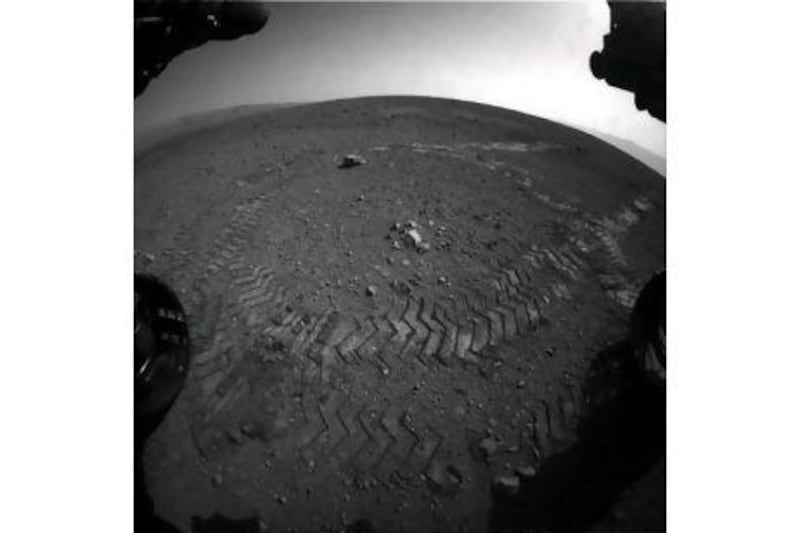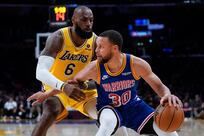ABU DHABI // Even by the cosmic standards of Nasa, its latest mission to Mars is a triumph. After an eight-month voyage across the abyss of space, the car-sized Curiosity rover plunged through the Martian atmosphere, before being slowed to a hover over its landing site by a parachute and rocket motors.
It was then gently winched down to the surface and cut free - just a few thousand metres from its target after a journey of more than half a billion kilometres. Last week it began trundling round in search of evidence that Mars once harboured life.
No one is more delighted than Nasa's engineers, who have learned the hard way how best to reach the Red Planet. Almost half of their first 14 probes there failed before they could send back any data, prompting jokes about Martians resenting human interest in their planet.
Nasa's engineers have now succeeded in every one of their last seven missions, suggesting the occupants of the Red Planet have decided resistance is futile.
Where and what they are may now be revealed by Curiosity. At least, that's the plan. The question is: would we recognise them even if we saw them?
It's a question with special poignancy to Nasa, following perplexing discoveries made by the two probes it sent to Mars in the mid-1970s.
The Viking missions were equipped with on-board labs, and carried out a series of tests on Martian soil. Some gave positive results, consistent with the existence of living organisms.
But others were negative or inconsistent - and, most tellingly, there seemed a lack of organic molecules expected from living organisms.
Officially the conclusion was that Viking had found evidence of weird chemical reactions on Mars, not life.
Yet some scientists, including Dr Gilbert Levin, who helped design Viking's lab tests, have long insisted the results cannot be so easily dismissed.
Their cause was boosted in 2008 when another Nasa lander, Phoenix, found so-called perchlorates in Martian samples. These could have destroyed all trace of life-related organic molecules in the Viking test.
It's an argument backed by research published in 2010, where perchlorates were mixed with soil from the Atacama Desert in Chile - the closest we have to Martian soil. The results were similar to those detected by Viking.
In April this year, Dr Levin also co-authored a study re-analysing the original Viking results, and found them consistent with the existence of life.
Now Curiosity will add its own insights, searching for organic molecules linked to life, and for the perchlorates capable of destroying them. The rover made a start last week, by zapping a nearby rock with its ChemCam laser "gun", and analysing the light for telltale signs of organic chemicals. It also has a drill to get deep inside any promising samples.
What Curiosity cannot do, however, is any biological testing. This has annoyed some scientists, while others suspect it may be a ruse.
Bluntly, Nasa is struggling to win funding from the US Congress, and knows the idea of finding life on Mars is a good way to keep the money coming in. That might change if the $2.5 billion price tag for Curiosity leads only to another Viking-style debacle.
So Curiosity's mission is really to find out whether Mars is - or ever was - habitable. It's an aim more likely to deliver hard facts capable of justifying future missions.
But it also helps overcome the problem highlighted by Viking: designing biological experiments requires assumptions about alien life - and these could prove very wide of the mark.
Life here on Earth has given biologists enough lessons in humility. Once, it was thought every organism ultimately derived its energy from the sun - either directly, like plants, or indirectly, via consuming those that do.
Then in the mid-1990s, scientists found bacteria living in total darkness far below the surface, off nothing but chemical reactions between water and rock.
Bacteria have also been found thriving in supposedly lethal environments from glaciers to the Dead Sea, and even in irradiated food.
Biologists once believed reproduction needed genetic material like DNA to carry the instructions down the generations.
Then they discovered prions - "infectious proteins" that make copies of themselves without the need for genes (and which cause mad cow disease and a range of similar, deadly ailments).
It seems likely that alien life will still have some features in common with life on Earth - such as reproducing structures made from relatively complex organic molecules. Some scientists think the parallels may run much deeper, because they suspect that life on Earth actually originated on the Red Planet.
This astonishing possibility has been explored in detail by the British astrobiologist Professor Paul Davies at Arizona State University, who argues that meteors from Mars may have seeded life on Earth.
His reasoning is that following the formation of the solar system around 4.5 billion years ago, Mars would have cooled down faster than the Earth, because of its smaller size. That would have made it a more hospitable place for the formation of life than the still-molten Earth. It may even have harboured water - whose presence is also being sought by Curiosity.
According to Prof Davies, simple Martian lifeforms may then have left the planet inside meteors catapulted off the Red Planet by cosmic impacts.
These meteors would then travel in towards the Earth, dumping their microbial cargoes on our planet where they evolved into us.
Far-fetched? Perhaps not: scientists have found around 100 meteorites from Mars, their origins proven by the fact they contain tiny pockets of gas identical to the atmosphere of Mars.
As for microbes surviving the journey from Mars to Earth, we already know of bugs well-able to live inside rock blasted by heat, cold and radiation.
So over the coming months, Curiosity may do more than reveal whether Mars has ever harboured life. It may also uncover evidence of our own origins long ago on that distant world.
- Robert Matthews is visiting reader in science at Aston University, Birmingham, England






